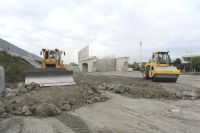Vienna - Salzburg High Performance Railway Line, Freight Train By-Pass St. Pölten, Middle Sector
Client: Austrian Railways Infrastructure AG
Development Period: 1992 to 2017
The freight train by-pass St. Pölten comprises a 25 km long, double-track new railway line. It was planned to relieve the Western Railway Line at the highly frequented urban area of St. Pölten of the freight and through traffic.
The line runs first of all along the S 33 motorway and then parallel to the A 1 Western Motorway. Only shortly before joining the existing line, the route turns away to the north.
The middle sector includes first an 8 km long open section, situated on an embankment. Subsequently, the track is crossing below a mountain ridge by the Pummersdorf Tunnel with a length of 3.5 km, built with the mining method. After the western portal, another open section with a length of 800 m follows. Within the open section, 15 bridges were implemented.
BGG Consult attended to the project since the beginning of the environmental impact assessment (EIA) in all matters of geotechnics and hydrogeology. In the run-up of the EIA and the building permission procedure, subsoil investigation campaigns were planned and technically and commercially supervised. The campaigns were adjusted to the respective problem definition and to the required levels of detail. Based on the results, Geotechnical and Hydrogeological Expert's Reports were compiled for the permission documents.
The tender project has been intensely accompanied, especially with regard to the use of the excavation material from the tunnel.
During construction, an expert's supervision and the hydrogeological preservation of evidence were provided.
Utilisation of the material from the tunnel excavation:
The tunnel excavation works have been tendered together with the embankment fills of the open track. The cubature of the latter was a little less than the tunnel volume. This should ensure an optimal utilisation of the excavation material from the tunnel. However, for commercial considerations, a highest possible freedom had to be given to the applicants with regard to the choice of the tunnel excavation method. Therefore, the tender included a variant with the mining technique by means of the NATM on the one hand, and a mechanized excavation (TBM) on the other hand. For the last-mentioned method, the necessity of a protection by means of an earth pressure balance shield had to be considered for parts of the tunnel. But the resulting slurrification would have had a significant deteriorating effect on the fill material. In this connection, it was important to narrow the sections where this method is required on the one hand and to evaluate the condition for a use of the material on the other hand. For the latter, the excavation and stabilisation processes have been simulated in the laboratory and tests conducted on samples gained in this way.
Eventually, the mining method was carried out as the most economical variant.
May 2017
